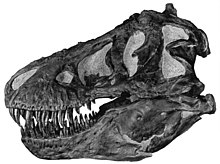啃咬



啃咬(biting)是动物中常见的一种行为,指用颚部的主动用力闭合夹击其它物体。在啃咬过程中,咀嚼肌中肌纤维的收缩会产生拉力施加在颚部的颌骨关节上,先让颚部张开,等目标物体出于上下颌之间后再迅速闭合颚部产生夹击[2]。如果颌骨上长有较为坚硬的牙齿,则可以通过足够大的咬合力穿透目标物体的表面,达到切割、撕裂或砸碎的作用。啃咬行为在有牙齿的有颌动物(比如哺乳动物、爬行动物、两栖动物和一些掠食性鱼类)中十分常见,但是鸟类和一些有特殊口器的无脊椎动物(比如节肢动物和头足类软体动物)也会展现明显的啃咬行为。动物的咬合技能可以用来完成进食、捕猎、打斗、筑巢[3]、搬运[4][5]、养幼甚至社交等一系列行为,是宏观生物重要的生存技能。
在汉语中,“咬”一般指快速且较有冲击力的闭颚行为;“啃”则指较慢但压力更大、或重复性的咬合;而力量较轻、主要用来搬运物体的咬合通常称作“叼”。许多节肢动物口器造成的伤害在口语中也被称为“咬”,但其实大部分是穿刺型伤害,准确来说应称为“叮”。
啃咬对目标生物体组织造成的创伤统称咬伤,根据牙齿形态和咬合力的不同可以产生贯穿伤、撕裂伤、瘀伤、骨折等不同形态的伤口,使得被咬者遭受流血、感染、传染病[6][7]、神经受损[8]、中毒[9][10]、截肢、瘫痪残疾甚至死亡等恶性后果[11]。在人类社会,最常见的来自动物的咬伤是犬类咬伤[12],其次是猫咬伤和猴子咬伤,此外广为大众所知的是蛇咬伤和鲨鱼袭击。
另见
[编辑]参照
[编辑]- ^ Archived copy. [2014-03-13]. (原始内容存档于2014-03-29).
- ^ Ferrara, T.L.; Clausen, P.; Huber, D.R.; McHenry, C.R.; Peddemors, V.; Wroe, S. Mechanics of biting in great white and sandtiger sharks. Journal of Biomechanics. 2011, 44 (3): 430–435. PMID 21129747. doi:10.1016/j.jbiomech.2010.09.028.
- ^ Müller-Schwarze, Dietland. Form, Weight, and Special Adaptations. The Beaver: Its Life and Impact. Cornell University Press. 2011: 11–8 [2022-06-29]. ISBN 978-0-8014-6086-9. (原始内容存档于2018-12-26).
- ^ Nguyen, Vienny; Lilly, Blaine; Castro, Carlos. The exoskeletal structure and tensile loading behavior of an ant neck joint. Journal of Biomechanics. 2014, 47 (2): 497–504 [February 11, 2014]. PMID 24287400. doi:10.1016/j.jbiomech.2013.10.053. (原始内容存档于2022-03-23).
- ^ Drees, Bastiaan M. Medical Problems and Treatment Considerations for the Red Imported Fire Ant (PDF). Texas A&M University. December 2002 [2022-06-29]. (原始内容存档 (PDF)于2022-01-20).
- ^ "Mosquito Bites" (页面存档备份,存于互联网档案馆), Mayo Clinic, accessed June 28, 2019
- ^ "Tickborne Diseases of the United States" (页面存档备份,存于互联网档案馆), The Center for Disease Control, accessed June 28, 2019
- ^ Braitberg, G.; Segal, L. Spider bites - Assessment and management. Australian Family Physician. 2009, 38 (11): 862–7 [2018-11-19]. PMID 19893831. (原始内容存档于2010-01-07).
- ^ Harris, J. B.; Goonetilleke, A. Animal poisons and the nervous system: What the neurologist needs to know. Journal of Neurology, Neurosurgery & Psychiatry. 2004, 75: iii40–iii46. PMC 1765666
 . PMID 15316044. doi:10.1136/jnnp.2004.045724.
. PMID 15316044. doi:10.1136/jnnp.2004.045724. - ^ "Workplace Safety & Health Topics Venomous Spiders". cdc.gov. February 24, 2012. Retrieved 28 October 2018
- ^ Cherry, James. Feigin and Cherry's textbook of pediatric infectious diseases – Animal and Human Bites, Morven S. Edwards. Philadelphia, PA: Elsevier/Saunders. 2014. ISBN 978-1-4557-1177-2; Access provided by the University of Pittsburgh
- ^ Kenneth M. Phillips. Dog Bite Statistics. 2009-12-27 [2010-08-06]. (原始内容存档于2010-09-21).